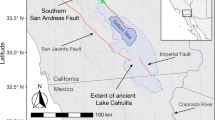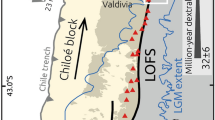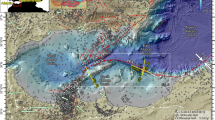Abstract
Since 1890, the San Jacinto fault in Southern California has been the site of eleven earthquakes of moderate magnitude (6<M<7) and tens of thousands of small earthquakes, but none of large magnitude1,2. This activity contrasts sharply with the seismic quiescence of the nearby southern San Andreas fault. Although this fault slips at a rate higher than that associated with the San Jacinto fault— 23–27 mm yr−1 versus 12–22 mm yr−1 (refs 3, 4)—it has produced very few earthquakes and no moderate or larger events in historical times. Here I use recent seismic and geodetic data to reveal that at depths of 10–17 km within the seismogenic (brittle) crust, the San Jacinto fault is creeping and releasing elastic strain by many small earthquakes. As a result, the accumulation of strain along this fault occurs mostly in its upper 10 km; moderate earthquakes are likely to be sufficient to release such strain. In contrast, the southern San Andreas fault accumulates elastic strain throughout its vertical extent in the seismogenic crust, which will most probably be released by stronger earthquakes.
This is a preview of subscription content, access via your institution
Access options
Subscribe to this journal
Receive 12 print issues and online access
$259.00 per year
only $21.58 per issue
Buy this article
- Purchase on Springer Link
- Instant access to full article PDF
Prices may be subject to local taxes which are calculated during checkout



Similar content being viewed by others
References
Lin, G. Q., Shearer, P. M. & Hauksson, E. Applying a three-dimensional velocity model, waveform cross correlation, and cluster analysis to locate southern California seismicity from 1981 to 2005. J. Geophys. Res. 112, B12309 (2007).
Kagan, Y. Y., Jackson, D. D. & Rong, Y. A new catalog of southern California earthquakes, 1800–2005. Seismol. Res. Lett. 77, 30–38 (2006).
Fialko, Y. Interseismic strain accumulation and the earthquake potential on the southern San Andreas fault system. Nature 441, 968–971 (2006).
Wdowinski, S., Smith-Konter, B., Bock, Y. & Sandwell, D. Diffuse interseismic deformation across the Pacific–North America plate boundary. Geology 35, 311–314 (2007).
Wdowinski, S., Sudman, Y. & Bock, Y. Geodetic detection of active faults in S. California. Geophys. Res. Lett. 28, 2321–2324 (2001).
Agnew, D. & Wyatt, F. SCEC Annual meeting (SCEC, 2005).
Sanders, C. & Magistrale, H. Segmentation of the northern San Jacinto fault zone, southern California. J. Geophys. Res. B 102, 27453–27467 (1997).
Doser, D. I. & Kanamori, H. Depth of seismicity in the Imperial Valley region, (1977–1983) and its relationship to heat flow, crustal structure, and the October 15, 1979, earthquake. J. Geophys. Res. 91, 675–688 (1986).
Schwartz, S. Y. & Rokosky, J. M. Slow slip events and seismic tremor at circum-pacific subduction zones. Rev. Geophys. 45, RG3004 (2007).
Wesnousky, S. G. Seismicity as a function of cumulative geologic offset—some observations from Southern California. Bull. Seismol. Soc. Am. 80, 1374–1381 (1990).
Ben-Zion, Y. & Lyakhovsky, V. Analysis of aftershocks in a lithospheric model with seismogenic zone governed by damage rheology. Geophys. J. Int. 165, 197–210 (2006).
Brune, J. N. Seismic moment, seismicity and rate of slip along major fault zones. J. Geophys. Res. 73, 777–784 (1968).
Shen, Z.-K. et al. The SCEC Crustal Motion Map, Version 3.0. (2003).
Working Group on California Earthquake Probabilities. Seismic hazard in Southern California: Probable earthquakes, 1994 to 2024. Bull. Seismol. Soc. Am. 85, 379–439 (1995).
Working Group on California Earthquake Probabilities. The Uniform California Earthquake Rupture Forecast, Version 2 (UCERF 2). USGS Open File Report 2007-1437 (USGS, 2007).
Acknowledgements
I thank Y. Ben-Zion, T. Dixon, F. Amelung and S. Eriksson for their comments and suggestions. I am also grateful to D. Jackson for his very helpful review. The relocated earthquake catalogue was provided by G. Lin.
Author information
Authors and Affiliations
Corresponding author
Supplementary information
Supplementary Information
Supplementary Information (PDF 524 kb)
Rights and permissions
About this article
Cite this article
Wdowinski, S. Deep creep as a cause for the excess seismicity along the San Jacinto fault. Nature Geosci 2, 882–885 (2009). https://doi.org/10.1038/ngeo684
Received:
Accepted:
Published:
Issue Date:
DOI: https://doi.org/10.1038/ngeo684
This article is cited by
-
Spatiotemporal Variations of Stress and Strain Parameters in the San Jacinto Fault Zone
Pure and Applied Geophysics (2019)
-
Interseismic Strain Localization in the San Jacinto Fault Zone
Pure and Applied Geophysics (2014)
-
The 2010 M w 7.2 El Mayor-Cucapah Earthquake Sequence, Baja California, Mexico and Southernmost California, USA: Active Seismotectonics along the Mexican Pacific Margin
Pure and Applied Geophysics (2011)



